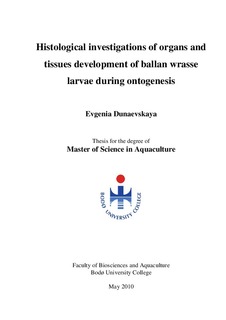| dc.description.abstract | The main objective of the present work was to study the larval development of the most
promising cleaner fish Labrus bergylta which have not been described previously. The present
study provides valuable information on its structural status during ontogeny, and it can be useful
for establishing the functional systemic capabilities and physiological requirements of larvae for
optimal welfare and growth.
Gross morphology of the larvae was examined using a stereomicroscope. Organs and
tissues of ballan wrasse larvae of different ages were studied with light microscopy. For light
microscopic studies, Haematoxilin and eosin staining, Alcian blue-PAS (pH 2.5) techniques
were used. The ontogeny of the Ballan wrasse larvae was studied by means of morphological
and histological approaches from 0 until 49 days after hatching (DAH). Larvae were hatched
form eggs obtained by natural spawning from a wild caught broodstock held in captivity. With
reference to the main external morphological characteristics and source of food, larva
development was divided into four stages: (1) Yolk sac larva (0-9 DAH), (2) Preflexion larva,
(10-25 DAH); (3) Flexion larva (26-33 DAH); (4) Postflexion larva (34-49). The organ
development in larvae was very prominent during the first three stages. Development during
stage 4 was characterized by the proliferation and growth of existing structures. At hatching, the
mouth and anus were closed, eyes were not pigmented, and digestive tract was an
undifferentiated and straight tube. The majority of the organs were observed as undifferentiated
groups of cells or primordial structures. Pericardic cavity, urinary bladder and exocrine pancreas
anlages were seen. During stage 1 both the mouth and the anus opened in conjunction with the
differentiation of the digestive tract. Buccopharyngeal cavity, oesophagus, stomach midgut and
hindgut were distinguished. Primordial structures of liver, swim bladder, gall bladder, gills,
pituitary and kidney appeared. Lecitoexotrophic period started when eyes were pigmented and
larvae were ready for capture of the prey and feeding. As ingestion of prey began, the digestive
processes continued developing with the appearance of mucous cells in the oesophagus, gut folds
and brush border in the intestine. The circulatory system became functional, with the
compartmentalization of the heart. During stage 2 (and 3) first haematopoietic tissue appeared.
Endocrine part of pancreas – Langerhans islet was evident. Taste buds were seen in the
oesophagus and skin. Throughout stage 3 thyroid follicles appeared, gill structures continued
developing. Number of mucous cells in the oesophagus increased and first mucous cells
appeared in the gill opening. During stage 4, gill filaments and lamellae proliferated, the number
of mucous cells in gill opening region increased. Most organs essentially exhibited an increase in
tissue structure and size. | en_US |
